外研版七年级上册 Module 9People and places-Unit 3 Language in use课件(共22张PPT)
文档属性
| 名称 | 外研版七年级上册 Module 9People and places-Unit 3 Language in use课件(共22张PPT) | 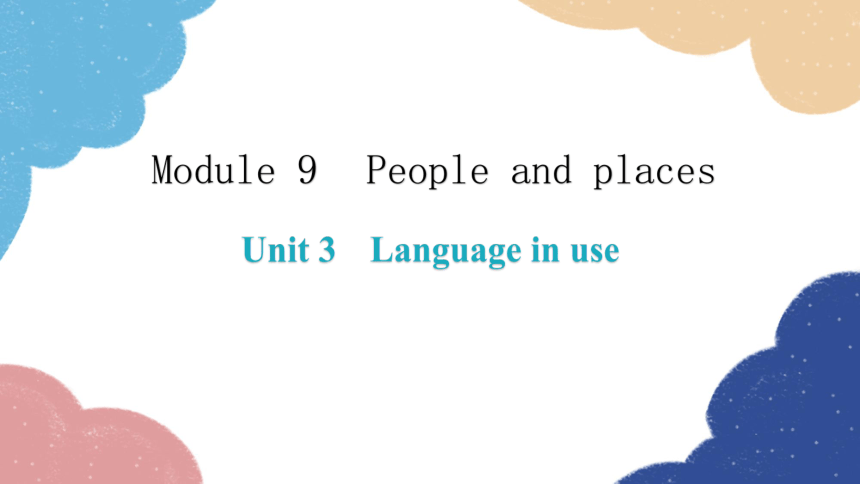 | |
| 格式 | pptx | ||
| 文件大小 | 413.6KB | ||
| 资源类型 | 教案 | ||
| 版本资源 | 外研版 | ||
| 科目 | 英语 | ||
| 更新时间 | 2022-11-16 18:28:47 | ||
图片预览

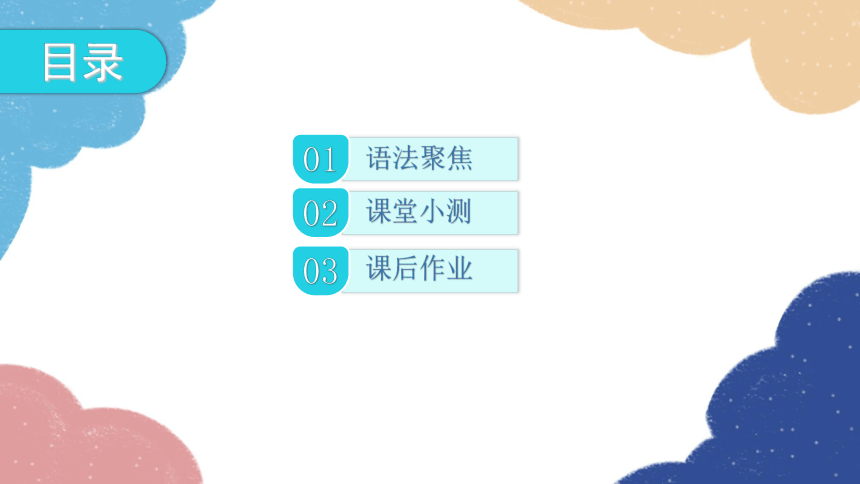
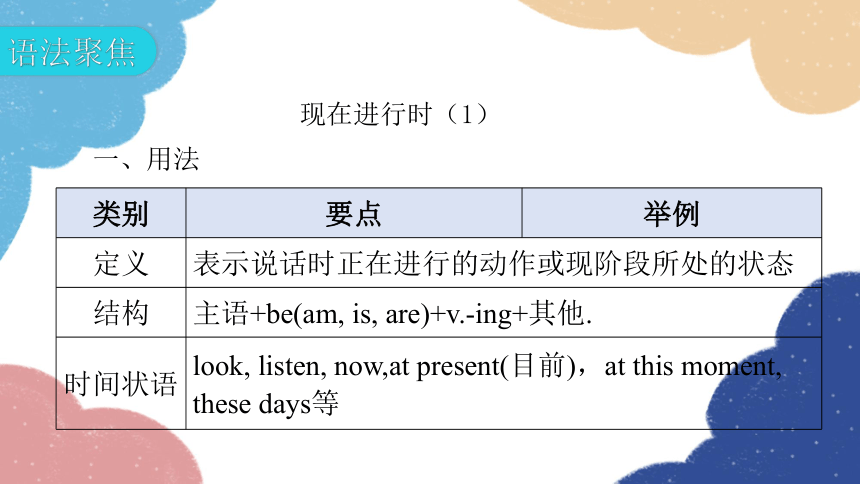
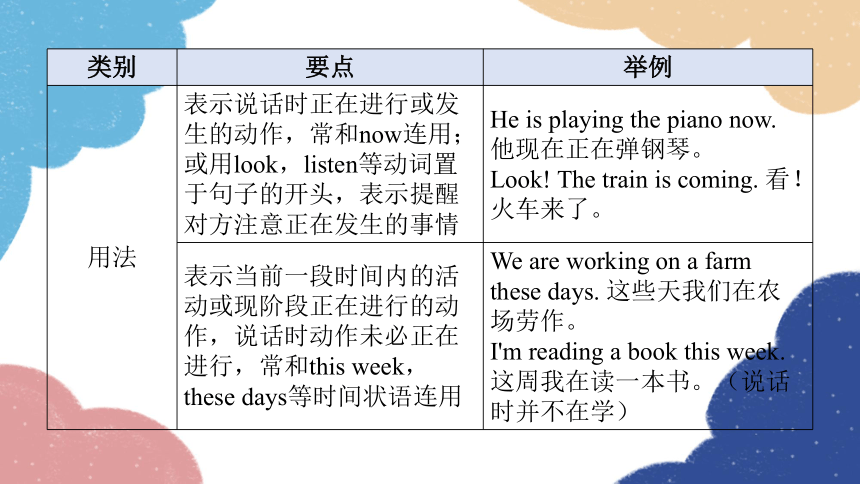
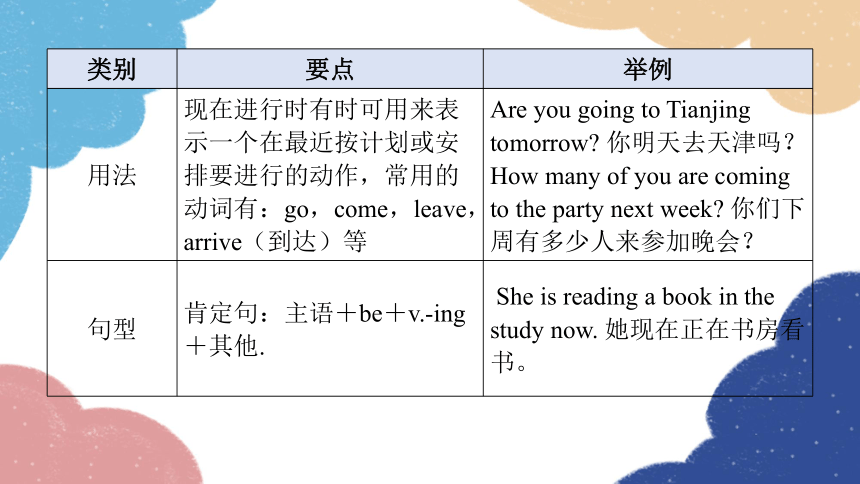
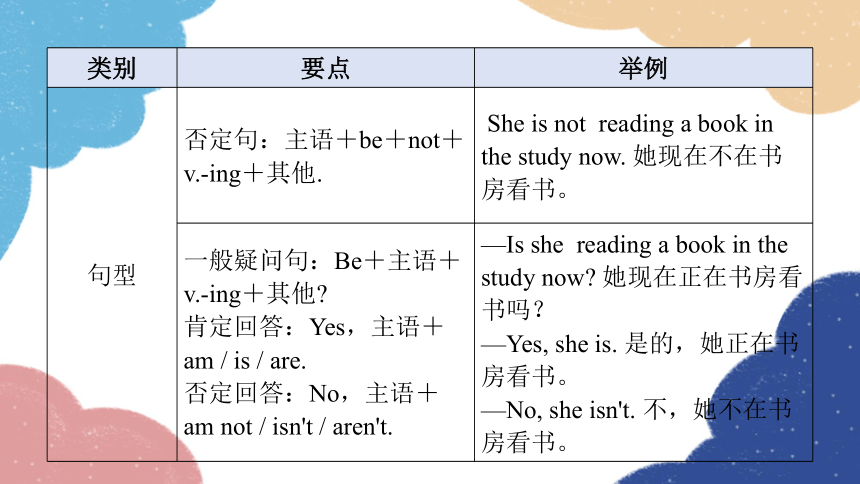

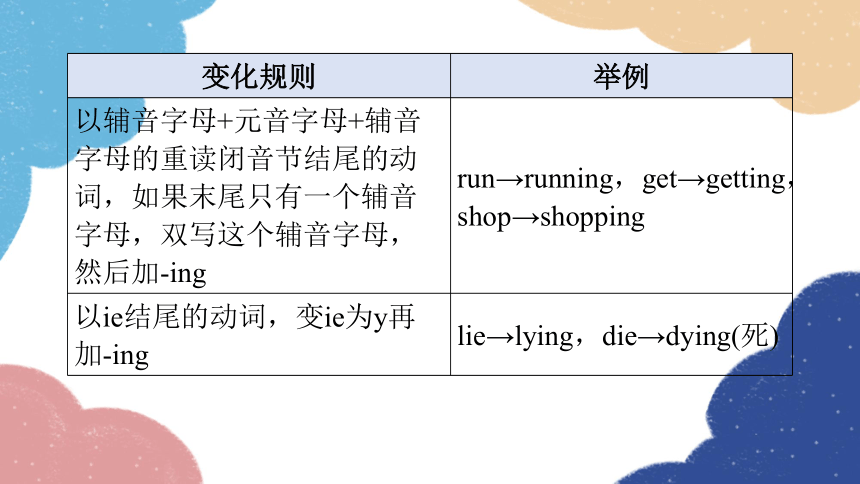
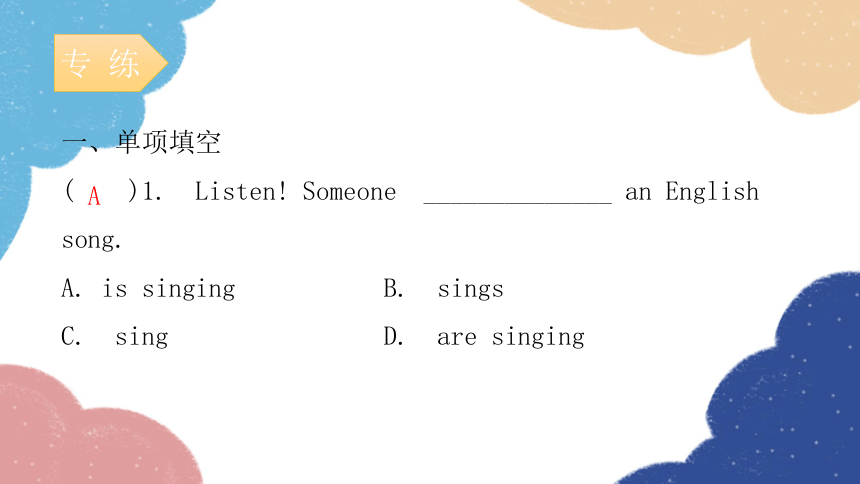
文档简介
(共22张PPT)
Module 9 People and places
Unit 3 Language in use
目录
02
课堂小测
03
课后作业
01
语法聚焦
现在进行时(1)
一、用法
语法聚焦
类别 要点 举例
定义 表示说话时正在进行的动作或现阶段所处的状态
结构 主语+be(am, is, are)+v.-ing+其他.
时间状语 look, listen, now,at present(目前),at this moment, these days等
类别 要点 举例
用法 表示说话时正在进行或发生的动作,常和now连用;或用look,listen等动词置于句子的开头,表示提醒对方注意正在发生的事情 He is playing the piano now. 他现在正在弹钢琴。
Look! The train is coming. 看!火车来了。
表示当前一段时间内的活动或现阶段正在进行的动作,说话时动作未必正在进行,常和this week,these days等时间状语连用 We are working on a farm these days. 这些天我们在农场劳作。
I'm reading a book this week.这周我在读一本书。(说话时并不在学)
类别 要点 举例
用法 现在进行时有时可用来表示一个在最近按计划或安排要进行的动作,常用的动词有:go,come,leave,arrive(到达)等 Are you going to Tianjing tomorrow 你明天去天津吗?
How many of you are coming to the party next week 你们下周有多少人来参加晚会?
句型 肯定句:主语+be+v.-ing+其他. She is reading a book in the study now. 她现在正在书房看书。
类别 要点 举例
句型 否定句:主语+be+not+v.-ing+其他. She is not reading a book in the study now. 她现在不在书房看书。
一般疑问句:Be+主语+v.-ing+其他 肯定回答:Yes,主语+am / is / are. 否定回答:No,主语+am not / isn't / aren't. —Is she reading a book in the study now 她现在正在书房看书吗?
—Yes, she is. 是的,她正在书房看书。
—No, she isn't. 不,她不在书房看书。
二、现在分词的变化规则
变化规则 举例
一般情况下,动词后直接加-ing work→working,visit→visiting,buy→buying
以不发音字母e结尾的动词,去掉e,然后加-ing take→taking,write→writing,have→having
变化规则 举例
以辅音字母+元音字母+辅音字母的重读闭音节结尾的动词,如果末尾只有一个辅音字母,双写这个辅音字母,然后加-ing run→running,get→getting,shop→shopping
以ie结尾的动词,变ie为y再加-ing lie→lying,die→dying(死)
一、单项填空
( )1. Listen! Someone ______________ an English song.
A. is singing B. sings
C. sing D. are singing
专 练
A
( )2. Look!Tom ______________ on the grass.
A. are lying B. is lying
C. lie D. lies
( )3. —What ______________ your father ______________
—He is reading a magazine.
A. are; doing B. is; do
C. is; doing D. are; do
B
C
( )4. Some boys ______________ computer games now.
A. plays B. are playing C. is playing D. play
( )5. I ______________ for Beijing tomorrow with my parents.
A. is leaving B. leave C. leaves D. am leaving
B
D
二、用所给单词的适当形式填空
6. It's nine o'clock. She ______________ (read)a story to her son.
7. My sister and brother _________________ (watch)TV at this moment.
8. Those men _________________ (not work)now.
is reading
are watching
aren't working
9. Look! My cousin ______________ (write)email.
10. At present Lily and Lucy ______________(learn)to draw pictures.
is writing
are learning
一、用所给单词的适当形式填空
1. It's seven o'clock now and I ______________ (walk) to school.
2. Look!Two men ______________ (run) after a dog.
3. Tom _____________________ (not study) now. He is in the playground.
课堂小测
am walking
are running
isn't studying
4. Mike_________________ (lie) on the beach and enjoying the sun.
5. Lucy__________________ (send) a letter to her friend at the moment.
is lying
is sending
二、根据要求完成句子,每空一词
6. They are talking about the new book. (改为否定句)
They ______________ ______________ about the new book.
7. She is having breakfast with her parents.(改为一般疑问句)
______________ ______________ ______________ breakfast with her parents
aren't
talking
Is
she
having
8. I am shopping with my mother.(改为一般疑问句)
_________ _______ ______________ with ______________ mother
9. Li Fei is taking photos with her friend.(就画线部分提问)
__________ ______________ Li Fei ______________ with her friend
Are
you
shopping
your
What
is
doing
10. His mother is standing on the Great Wall. (就画线部分提问)
______________ ______________ his mother ______________
Where
is
standing
三、语法选择
It's fine on Saturday morning. There __11__ many children in the park. They are having __12__ good time. Some of them are enjoying playing games under a big tree. The girls are singing and __13__. The boys are taking __14__. Michael is __15__ by the lake. __16__ is reading a storybook. __17__ is Linda She's standing over there __18__ her sister. They are eating ice cream. Look!__19__ are the two girls They are Betty and Anna. Let's go and __20__ with them.
( )11. A. is B. am C. are
( )12. A. an B. a C. the
( )13. A. dancing B. to dance C. dance
( )14. A. photo B. photos C. photo's
( )15. A. sits B. to sit C. sitting
( )16. A. His B. He C. Him
C
B
A
B
C
B
( )17. A. Where B. What C. How
( )18. A. with B. and C. for
( )19. A. When B. Whose C. Who
( )20. A. to talk B. talk C. talking
A
A
C
B
THANKS!
Module 9 People and places
Unit 3 Language in use
目录
02
课堂小测
03
课后作业
01
语法聚焦
现在进行时(1)
一、用法
语法聚焦
类别 要点 举例
定义 表示说话时正在进行的动作或现阶段所处的状态
结构 主语+be(am, is, are)+v.-ing+其他.
时间状语 look, listen, now,at present(目前),at this moment, these days等
类别 要点 举例
用法 表示说话时正在进行或发生的动作,常和now连用;或用look,listen等动词置于句子的开头,表示提醒对方注意正在发生的事情 He is playing the piano now. 他现在正在弹钢琴。
Look! The train is coming. 看!火车来了。
表示当前一段时间内的活动或现阶段正在进行的动作,说话时动作未必正在进行,常和this week,these days等时间状语连用 We are working on a farm these days. 这些天我们在农场劳作。
I'm reading a book this week.这周我在读一本书。(说话时并不在学)
类别 要点 举例
用法 现在进行时有时可用来表示一个在最近按计划或安排要进行的动作,常用的动词有:go,come,leave,arrive(到达)等 Are you going to Tianjing tomorrow 你明天去天津吗?
How many of you are coming to the party next week 你们下周有多少人来参加晚会?
句型 肯定句:主语+be+v.-ing+其他. She is reading a book in the study now. 她现在正在书房看书。
类别 要点 举例
句型 否定句:主语+be+not+v.-ing+其他. She is not reading a book in the study now. 她现在不在书房看书。
一般疑问句:Be+主语+v.-ing+其他 肯定回答:Yes,主语+am / is / are. 否定回答:No,主语+am not / isn't / aren't. —Is she reading a book in the study now 她现在正在书房看书吗?
—Yes, she is. 是的,她正在书房看书。
—No, she isn't. 不,她不在书房看书。
二、现在分词的变化规则
变化规则 举例
一般情况下,动词后直接加-ing work→working,visit→visiting,buy→buying
以不发音字母e结尾的动词,去掉e,然后加-ing take→taking,write→writing,have→having
变化规则 举例
以辅音字母+元音字母+辅音字母的重读闭音节结尾的动词,如果末尾只有一个辅音字母,双写这个辅音字母,然后加-ing run→running,get→getting,shop→shopping
以ie结尾的动词,变ie为y再加-ing lie→lying,die→dying(死)
一、单项填空
( )1. Listen! Someone ______________ an English song.
A. is singing B. sings
C. sing D. are singing
专 练
A
( )2. Look!Tom ______________ on the grass.
A. are lying B. is lying
C. lie D. lies
( )3. —What ______________ your father ______________
—He is reading a magazine.
A. are; doing B. is; do
C. is; doing D. are; do
B
C
( )4. Some boys ______________ computer games now.
A. plays B. are playing C. is playing D. play
( )5. I ______________ for Beijing tomorrow with my parents.
A. is leaving B. leave C. leaves D. am leaving
B
D
二、用所给单词的适当形式填空
6. It's nine o'clock. She ______________ (read)a story to her son.
7. My sister and brother _________________ (watch)TV at this moment.
8. Those men _________________ (not work)now.
is reading
are watching
aren't working
9. Look! My cousin ______________ (write)email.
10. At present Lily and Lucy ______________(learn)to draw pictures.
is writing
are learning
一、用所给单词的适当形式填空
1. It's seven o'clock now and I ______________ (walk) to school.
2. Look!Two men ______________ (run) after a dog.
3. Tom _____________________ (not study) now. He is in the playground.
课堂小测
am walking
are running
isn't studying
4. Mike_________________ (lie) on the beach and enjoying the sun.
5. Lucy__________________ (send) a letter to her friend at the moment.
is lying
is sending
二、根据要求完成句子,每空一词
6. They are talking about the new book. (改为否定句)
They ______________ ______________ about the new book.
7. She is having breakfast with her parents.(改为一般疑问句)
______________ ______________ ______________ breakfast with her parents
aren't
talking
Is
she
having
8. I am shopping with my mother.(改为一般疑问句)
_________ _______ ______________ with ______________ mother
9. Li Fei is taking photos with her friend.(就画线部分提问)
__________ ______________ Li Fei ______________ with her friend
Are
you
shopping
your
What
is
doing
10. His mother is standing on the Great Wall. (就画线部分提问)
______________ ______________ his mother ______________
Where
is
standing
三、语法选择
It's fine on Saturday morning. There __11__ many children in the park. They are having __12__ good time. Some of them are enjoying playing games under a big tree. The girls are singing and __13__. The boys are taking __14__. Michael is __15__ by the lake. __16__ is reading a storybook. __17__ is Linda She's standing over there __18__ her sister. They are eating ice cream. Look!__19__ are the two girls They are Betty and Anna. Let's go and __20__ with them.
( )11. A. is B. am C. are
( )12. A. an B. a C. the
( )13. A. dancing B. to dance C. dance
( )14. A. photo B. photos C. photo's
( )15. A. sits B. to sit C. sitting
( )16. A. His B. He C. Him
C
B
A
B
C
B
( )17. A. Where B. What C. How
( )18. A. with B. and C. for
( )19. A. When B. Whose C. Who
( )20. A. to talk B. talk C. talking
A
A
C
B
THANKS!
同课章节目录
- Starte
- Module 1 My teacher and my friends
- Module 2 My English lesson
- Module 3 My English book
- Module 4 My everyday life
- Module 1 My classmates
- Unit 1 Nice to meet you.
- Unit 2 I'm Wang Lingling and I'm thirteen years ol
- Unit 3 Language in use.
- Module 2 My family
- Unit 1 Is this your mum?
- Unit 2 These are my parents.
- Unit 3 Language in use.
- Module 3 My school
- Unit 1 There are thirty students in my class.
- Unit 2 The library is on the left of the playgroun
- Unit 3 Language in use.
- Module 4 Healthy food
- Unit 1 We've got lots of apples.
- Unit 2 Is your food and drink healthy?
- Unit 3 Language in use.
- Module 5 My school day
- Unit 1 I love history.
- Unit 2 We start work at nine o'clock.
- Unit 3 Language in use.
- Revision module A
- Module 6 A trip to the zoo
- Unit 1 Does it eat meat?
- Unit 2 The tiger lives in Asia.
- Unit 3 Language in use.
- Module 7 Computers
- Unit 1 How do I write my homework on the computer?
- Unit 2 When do you use a computer?
- Unit 3 Language in use.
- Module 8 Choosing presents
- Unit 1 I always like birthday parties.
- Unit 2 She often goes to concerts.
- Unit 3 Language in use.
- Module 9 People and places
- Unit 1 We're enjoying the school trip a lot.
- Unit 2 They're waiting for buses or trains.
- Unit 3 Language in use.
- Module 10 Spring Festival
- Unit 1 Are you getting ready for Spring Festival?
- Unit 2 My mother's cleaning our houses and sweepin
- Unit 3 Language in use.
- Revision module B
